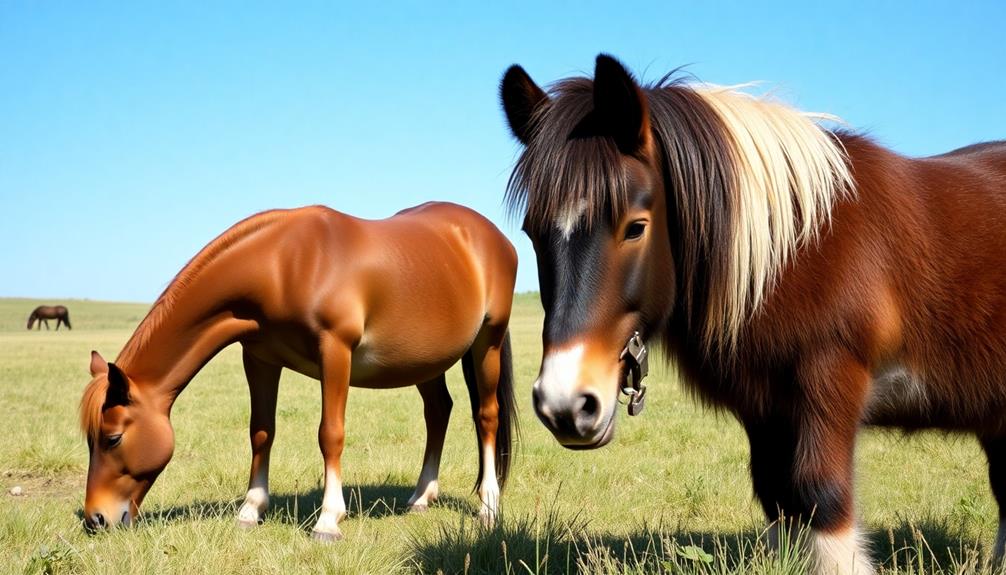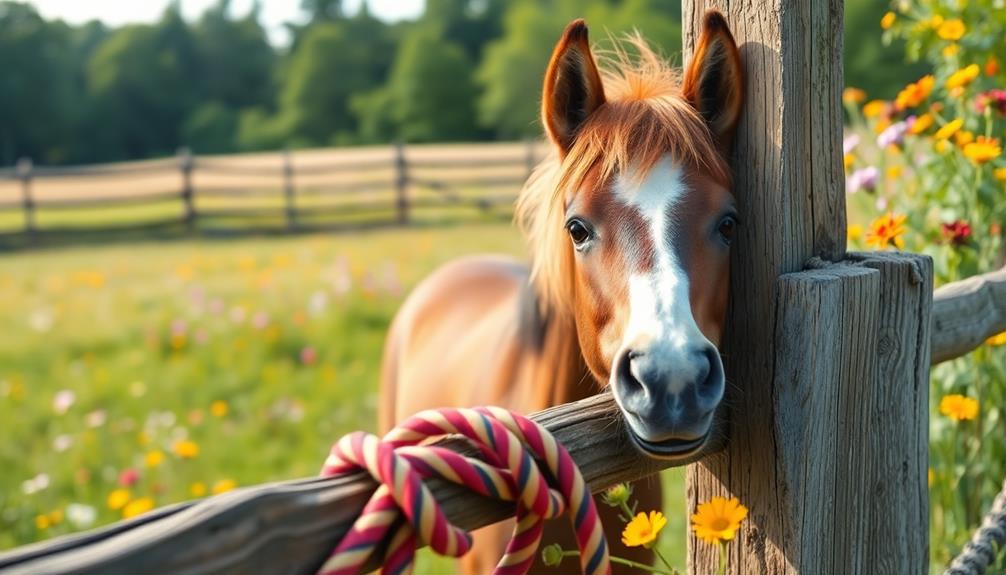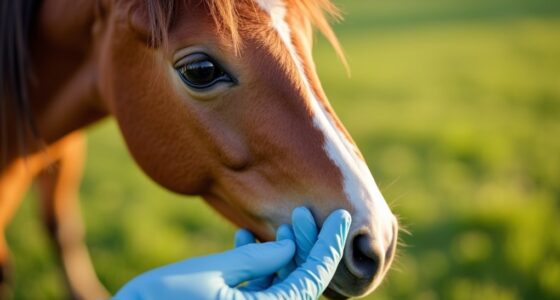Miniature horses and ponies differ mainly in size, purpose, and temperament. Miniature horses reach a maximum height of 38 inches, with registered ones under 34 inches, while ponies stand under 14.2 hands. Miniatures often have refined features and excel as therapy animals, while ponies are stockier and better suited for riding or work. Both groups need regular care and social interaction, but miniatures should not carry adult weight, unlike ponies. Understanding these differences can help you choose the right companion for your needs. Discover more about their unique traits and care requirements.
Key Takeaways
- Miniature horses are refined and max out at 38 inches, while ponies are stockier, classified under 14.2 hands (58 inches) tall.
- Miniature horses primarily serve as companion animals, whereas ponies are suited for riding and work-related tasks.
- Ponies can carry weight up to 20% of their body weight, but miniatures should not carry adult weight due to size limitations.
- Miniature horses are known for their gentle nature, while ponies can be more mischievous and require experienced handlers for effective training.
- Both types need regular veterinary care, balanced diets, and social interaction to maintain health and emotional well-being.
Size and Classification
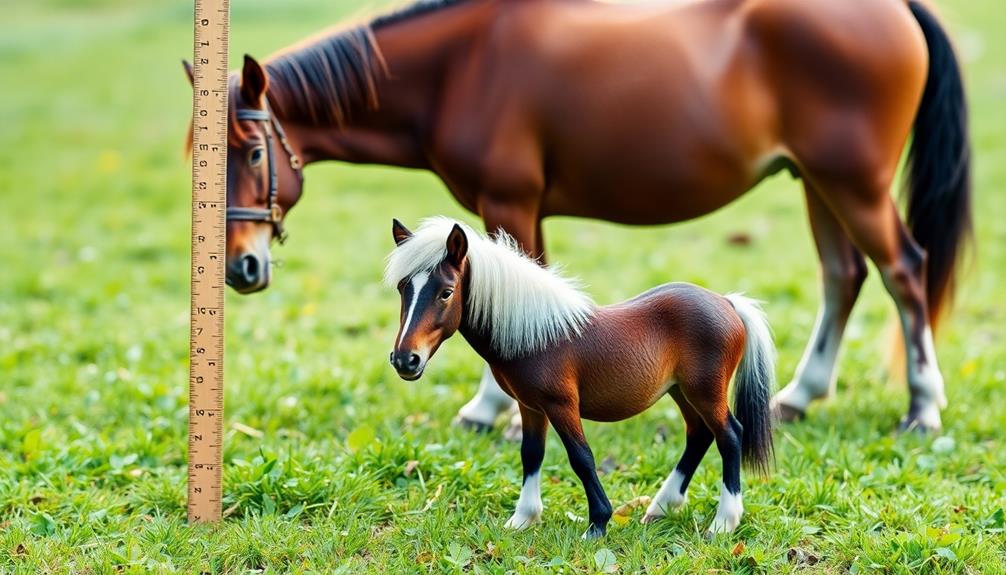
When it comes to size and classification, understanding the differences between miniature horses and ponies is essential. Miniature horses are defined as a breed with a maximum height of 38 inches, while ponies fall under the equine classification of those under 14.2 hands, or 58 inches tall. The American Miniature Horse Association (AMHA) specifies that registered miniature horses mustn't exceed 34 inches in height.
Curiously, the rising interest in young equine talents may help educate the public on these distinctions as more young riders showcase their skills with both miniature horses and ponies.
One key distinction lies in their builds; ponies typically exhibit stockier builds with thicker necks and shorter legs, making them sturdier overall. In contrast, miniature horses possess more refined features that closely resemble full-sized horses, showcasing elegance in their smaller size.
Misclassification often occurs due to the overlapping height requirements and marketing strategies that blur the lines between these two equine types. Many people might mistakenly perceive the smaller stature of miniature horses as just another type of pony.
Understanding these characteristics helps you accurately identify and appreciate the unique qualities of both miniature horses and ponies, ensuring you're well-informed when exploring the world of equines.
Physical Abilities and Health
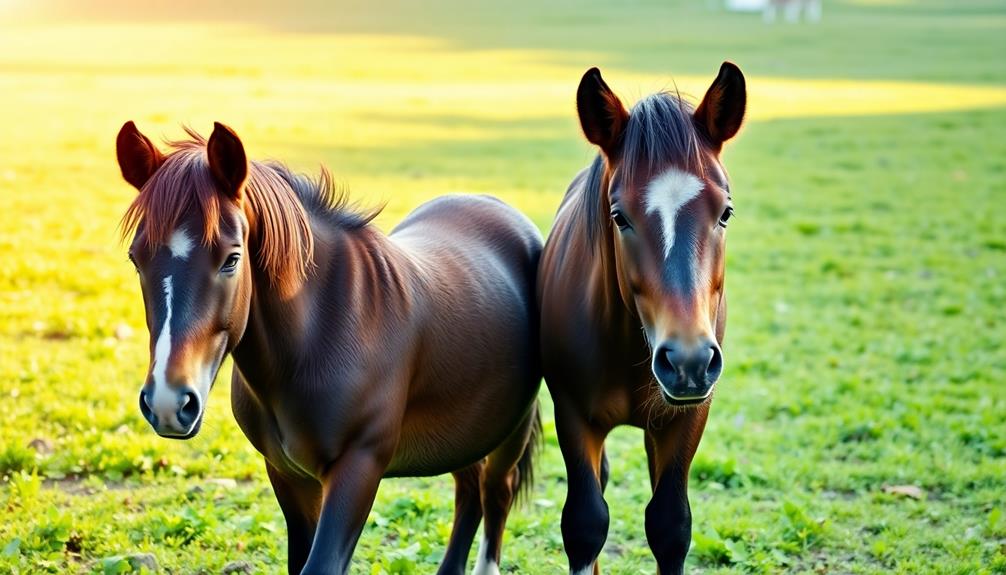
Understanding the physical abilities and health considerations of miniature horses and ponies is vital for any equine enthusiast. When comparing miniature horses vs. ponies, it's clear that while they share similar digestive, respiratory, and musculoskeletal systems, their physical differences impact their capabilities.
Miniature horses, often referred to as "minis," are primarily companion animals, whereas ponies, like Shetland ponies, are better suited for riding and work due to their larger size and strength. Individuals with Borderline Personality Disorder (BPD) often experience instability in their emotional responses, which can influence their interactions with animals, including equines.
Ponies can carry weight effectively, adhering to a weight limit of under 20% of their body weight, making them ideal for children and small adults. In contrast, miniature horses shouldn't carry adult weight, as it can pose health risks.
Both small equine groups face challenges like obesity, particularly miniature horses, whose breeding practices may affect their overall equine health.
Veterinary care is essential for both ponies and minis, as they require regular vaccinations, dental exams, and health monitoring. The Miniature Horse Association (AMHA) emphasizes the importance of understanding these health needs to guarantee the longevity and well-being of these delightful animals.
Behavioral Traits
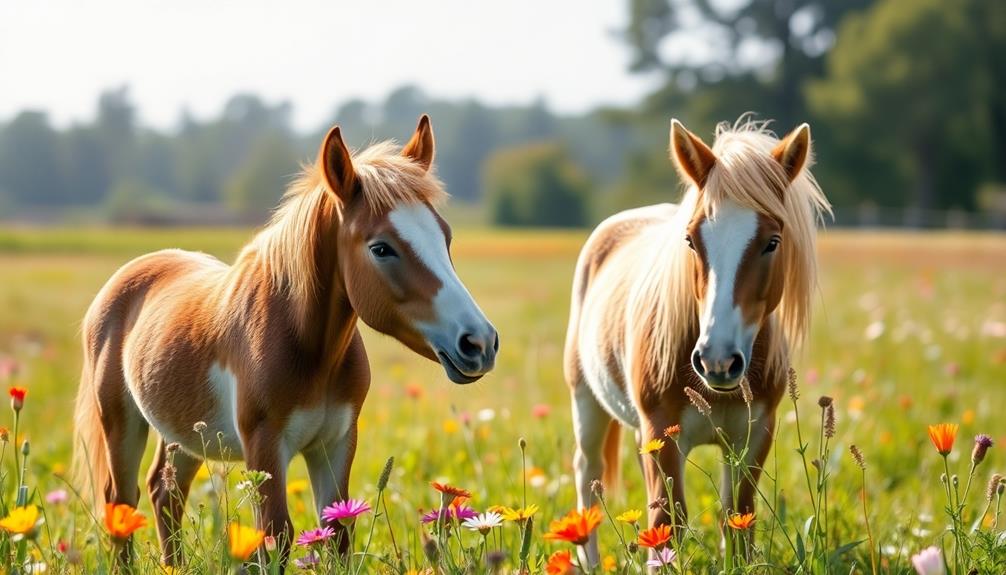
Behavior plays a vital role in distinguishing miniature horses from ponies. Miniature horses are celebrated for their gentle and affectionate personalities, making them exceptional therapy animals in hospitals and retirement homes. Their dog-like behavior enhances interaction with owners, solidifying their status as beloved companion animals.
Additionally, understanding the emotional needs of animals, such as support resources for caregivers, can greatly enhance the bond between humans and these small equines. On the other hand, ponies can be more mischievous and even outsmart inexperienced riders, leading to behavioral challenges that require experienced handlers for effective training.
Both miniature horses and ponies thrive on companionship, needing regular interaction to remain happy and healthy. Misunderstandings about pony behavior often arise from the rider's experience level rather than any inherent differences between these small horses. While ponies may exhibit playful antics, it's important to recognize that their behavior often stems from a desire for engagement and stimulation.
Training plays a significant role in shaping the behavior of both miniature horses and ponies. With the right approach, you can help them develop positive behaviors and overcome any challenges.
Understanding these differences can lead to more rewarding experiences with your small horse, whether it's for companionship, therapy, or simply enjoying their delightful personalities.
Care and Ownership Considerations
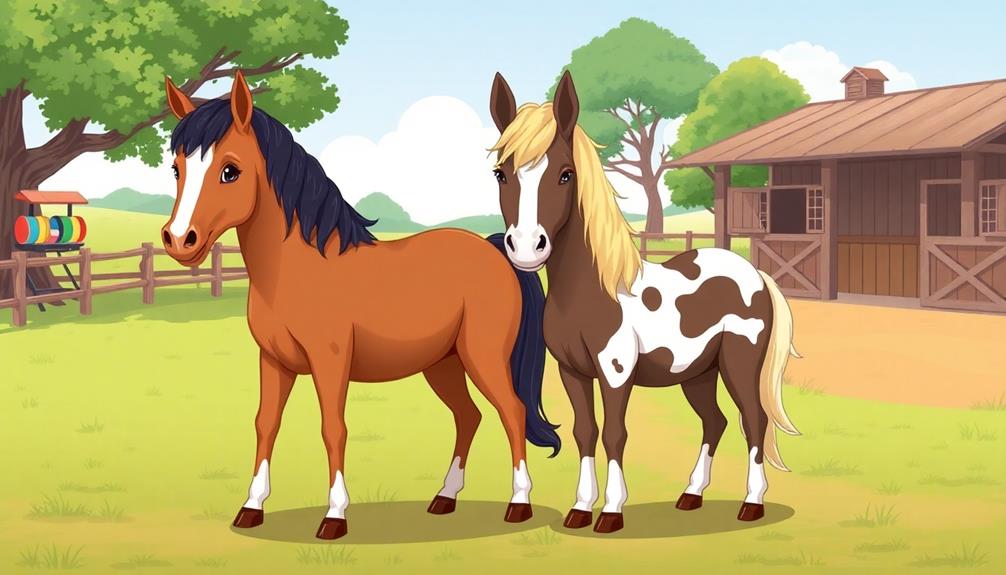
Owning a miniature horse or pony can be a rewarding experience, but it's essential to recognize their specific care needs. Many new owners underestimate the commitment required for proper ownership, which can lead to neglect if you don't assess your available resources.
Here are four important care considerations to keep in mind:
- Grooming: Regular grooming is crucial for both mini horses and ponies. It helps maintain their coat health and allows you to check for any skin issues.
- Veterinary Check-Ups: Schedule routine veterinary check-ups to monitor their overall health and catch any potential health issues early, such as obesity-related conditions.
- Balanced Diet: Provide a balanced diet tailored to their smaller size. This guarantees they receive the necessary nutrients without overfeeding.
- Social Interaction: Miniature horses and ponies thrive on companionship. Regular interaction keeps them mentally and emotionally healthy.
Before bringing a mini home, take the time to research and confirm you're ready for the commitment of caring for these adorable creatures.
The SPCA offers valuable resources to help potential owners prepare effectively.
Uses and Roles
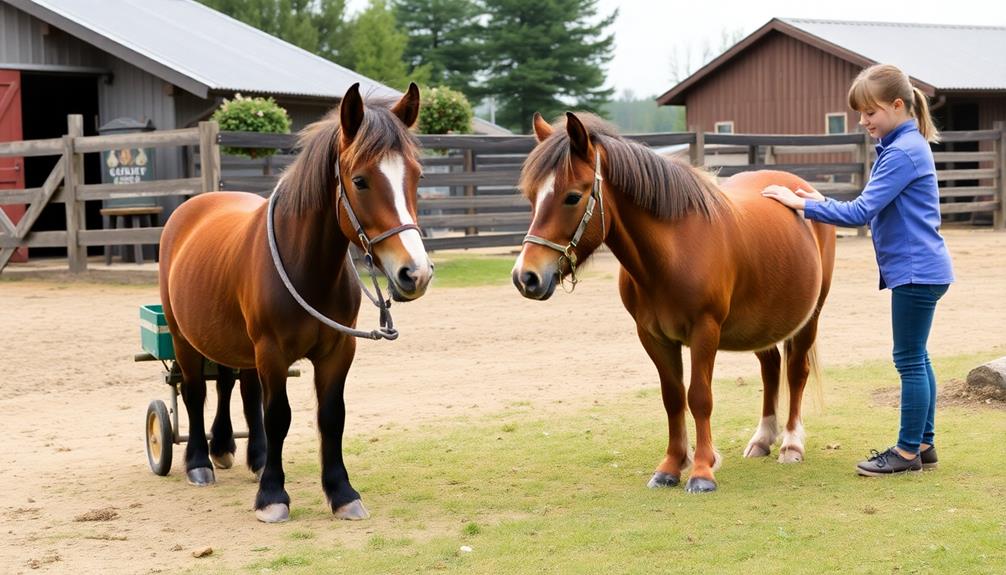
Miniature horses and ponies serve a variety of important roles that go beyond companionship. Both types bring unique skills and attributes to the table, making them valuable in diverse settings.
| Role | Description |
|---|---|
| Therapy Animals | Mini horses are gentle companions in hospitals and retirement homes. |
| Service Animals | Miniature horses can guide the visually impaired, highlighting their capabilities. |
| Equestrian Activities | Both mini horses and ponies participate in driving and in-hand classes, showcasing their talents. |
| Children's Mounts | Ponies, like the Shetland, are perfect for young riders in riding schools. |
| Agricultural Tasks | Ponies are often used in farm work, demonstrating strength despite their size. |
The Miniature Horse Association (AMHA) promotes the use of mini horses in various capacities, emphasizing their versatility. Whether you're considering a pony as a child's mount or a mini horse for therapeutic purposes, you'll find they offer tremendous value. Their manageable size makes them suitable alternatives to full-sized horses, opening up opportunities for many people to enjoy equestrian activities and more.
Frequently Asked Questions
Is a Pony and a Horse the Same Thing?
Think of a pony and a horse like different-sized shoes in the same style.
They're both part of the equine family, but they're not the same. Horses stand 14.2 hands tall or more, while ponies are under that height.
Ponies often have stockier builds and unique characteristics.
What Makes a Miniature Horse?
A miniature horse is defined by its height, standing at a maximum of 38 inches at the shoulder.
Unlike ponies, these little equines have proportions similar to full-sized horses, featuring finer traits and longer legs.
You'll find they were originally bred from Shetland ponies and have gentle temperaments, making them great companions.
What Size Is a Pony?
When you're wondering about pony size, remember that ponies measure under 14.2 hands high, which is about 58 inches or 147 cm at the shoulder.
This height classification sets them apart from taller horses.
While there are various pony breeds, they generally share a stockier build, with shorter legs and thicker necks.
What Is Another Name for a Miniature Horse?
Another name for a miniature horse is "mini horse."
These adorable little equines are specifically bred to resemble their full-sized counterparts, yet they stand under 38 inches tall. You might also hear people refer to them as "miniatures" to differentiate them from standard horses and ponies.
Their gentle nature often earns them the nickname "pocket ponies," especially when they're kept as companion animals, showcasing their charm and friendly demeanor.
Conclusion
In the world of equines, miniature horses and ponies are like two unique melodies in a harmonious symphony. While they may share a stage, their size, traits, and care needs set them apart. Understanding these differences helps you choose the right companion, ensuring you both dance through life together. Whether you're drawn to their playful spirit or gentle nature, knowing what makes each special will deepen your bond and enrich your journey with these delightful creatures.
